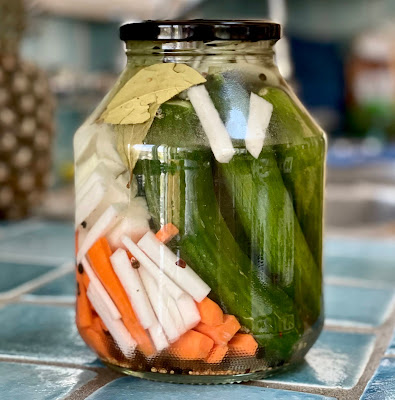To make Thanksgiving a success, a time line is essential. We started one last week. We planned the menu, which meant we could put together a shopping list. After I had visited my favorite markets, Super King Market (6501 San Fernando Road, Glendale Ca 91201) and the Santa Monica Whole Foods on Montana Avenue, I had what we need to make our feast.
Included on the time line was what comes next. After Thanksgiving comes Thanksgiving left-overs, which some in our family say is the best part of Thanksgiving.
Open faced sandwiches with turkey and my homemade turkey liver pate. Turkey soup made from the stock of Thanksgiving's bones and bits. And, my favorite, dumplings and turkey stew. The absolute best comfort food.
Simmer. Cover. Uncover. Serve. Easy and delicious.
Farm-to-Table Vegetables, Turkey and Dumplings
Use a good quality organic turkey and buy farmers market produce when available.
If you have dried whole shiitake mushrooms, use them. They add a distinctive flavor, different from the delicate flavor of thinly sliced shiitakes.
Use vegetables you love. And lots of them. English peas. Squash rounds. Kabocha chunks. Roasted sweet potatoes. Green beans. Kale. Shredded cabbage. Chopped turnips. My preference is to tilt the balance towards the fresh produce, plating great mounds of vegetables with a leg and a wing or two pieces of breast.
The dish can be covered and served the next day or divided into smaller covered containers and frozen for up to three months.
Yield: 4 servings
Time to prep: 15 minutes (if you already have turkey stock as described above) or 1 hour (including time to make turkey stock)
Time to cook: 30 minutes
Total time: 45 minutes - 1 hour 30 minutes
Ingredients
4 cups cooked turkey meat, cut into quarter sized pieces, no bones
1 medium yellow onion, washed, ends trimmed, outer skin removed, cut into 1/2" pieces
1 cup green beans, washed, ends removed, cut into 1" long pieces
1 cup broccoli florets, washed and cut into 1" pieces or broccoli leaves, washed, shredded
2 cups shiitake mushrooms, washed, stem end trimmed, thinly sliced or 2 cups dried whole shiitake mushrooms, washed
1/4 cup Italian parsley, leaves only, washed, finely chopped
1 garlic, peeled, finely chopped (optional)
1/2 cup celery, washed, ends trimmed, cut into 1/2" pieces (optional)
4 cups homemade turkey stock, as described above
1 large carrot, washed, trimmed, peeled, cut into 1/2" thick rounds
2 tablespoons extra virgin olive oil
1/4 teaspoon sea salt
Pinch freshly ground black pepper
Pinch cayenne powder (optional)
Dumpling ingredients
1 cup all-purpose flour, white
2 tablespoons sweet (unsalted) butter, cut into fine bits
1 teaspoon baking soda
1/4 teaspoon sea salt
Pinch freshly ground black pepper
1/2-1/3 cup half and half, cream or whole milk
Directions
Turkey stock can be used when made fresh or when thawed after having been frozen, as described above.
In a mixing bowl, add flour, cut up butter, scallion (or Italian parsley), baking soda, sea salt and black pepper. Using a fork, mix well. Slowly add milk, stirring until thickened. The resulting mixture should be like thick batter. If the mixture is too runny, add a tablespoon of flour. Cover and set aside.
In a large pot, heat olive oil and sauté onions and garlic (optional) with oil until softened. Add cooked turkey and vegetables. Season with sea salt and freshly ground black pepper. Add turkey stock. Stir and simmer 20 minutes.
To make the dumplings, use two soup spoons to create small rounds of dough. Drop each dumpling into the simmering liquid. Make room for each dumpling so they do not touch because they will expand as they cook. Use all the dumplings batter and cover.
Adjust the heat so the stock simmers but does not boil.
Cook 30 minutes and serve immediately. Place several dumplings into each bowl, adding a protein and a good helping of vegetables with several tablespoons of sauce.
Serve hot.


























